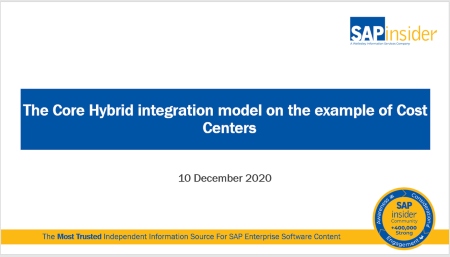Live from SAPinsider Studio: AIG’s Cost Allocations in SAP
Sharath Muthyala, IT Lead, EPM, AIG, joins SAPinsider Studio to discuss cost allocations and how his company built a new CAS (cost allocation system) engine in SAP for a more granular, product-level view of allocation processes.
This is an edited transcript of the discussion:
Ken Murphy, SAPinsider: Hi, this is Ken Murphy with SAPinsider. I’m at the SAPinsider Financials and GRC event in Las Vegas. Today, I am pleased to be joined by Sharath Muthyala, who is the IT lead in the SAP EPM space for AIG. Sharath, thanks for joining us today.
Explore related questions
Sharath Muthyala, AIG: Thank you for having me.
Ken: I was hoping to start if you could just tell our viewing audience a little bit about your cost allocation project, and just a little bit about what the project means for the business units and what it means for the company?
Sharath: This particular project, cost allocations, comes in a very critical juncture where the company undertook a lot of finance transformation activities. It is both on the GL side, general ledger, as well as the FP&A which is the financial planning and analysis side. So because cost allocation has to be run in actuals, which is part of the month-end close, and it also has to be run on the budget data as well which is the planning side. So it’s kind of a very core functionality that needs to be happening both in financial accounting as well as the managerial accounting side.
So this particular application or the solution that we put in brings in a lot of cost transparency. What the internal charges are, and how the expenses are broken down at the product level so that we know what expenses are really making or impacting our revenue stream. It’s a big undertaking.
Ken: And so have you been an SAP customer for quite some time?
Sharath: Yes, we have the traditional modules like SAP GL, we have reinsurance module, we have collections and dispersement, we have Solution Manager. We recently moved onto SAP Business Warehouse (SAP BW) powered by SAP HANA, last year. We’ve been with SAP for so long, even in the BPC side as well. We first started I think it was 2008 and we had the eighth BCPC implementation that we are currently undertaking right now.
Ken: A lot of processes running through BPC.
Sharath: And just to add to that, we run financial consolidations across AIG. We also run tax provisioning reports out of BPC. We also do expense planning which is top-down, bottom-up budgeting. And we also do the allocations which is what this whole implementation is about.
Ken: Maybe touch on some of the drivers for the project. How were you doing cost allocations prior to thinking of going in a different direction?
Sharath: WE have so many business units, so every business unit has their own process, their own methodology and their own code block itself. So a few business units performed a part of the product allocation process which is the chargebacks, they do it in GL but not the comprehensive product allocations. In some cases, they are completely offline meaning they run allocations in Excel VBA Macros or it could be access to databases as well. So to pool everything into BPC, we have a lot of challenges. One is at the organization level, the methodology, the code block, or even the legacy applications itself. So it’s a multitude of challenges that we had to tackle.
Ken: Can you address some of the way you tackled those issues and challenges, and maybe also from the technical side?
Sharath: So before we started even designing this solution, what we did is we know of our core guiding principles. Meaning the solution needs to be scalable, it has to be very flexible because the business units are separate legal entities has their own sub-processes of the allocation which they do manually. So to write code flexible enough to handle all of this is not an optimal process to put in SAP. So what we did is we created a generic calculation engine which we call a CAS engine which stands for Cost Allocation System where if I had to delve into more technical details, this CAS engine takes all the allocation factors and rules from the cost center profile, applies them to the input data, and then you will get the post-allocation result which could be service charges, how it is processed, it could be an expense breakdown on the product line. And it also does a lot of the calculations which have traditionally been done manually which is the DAC, the deferred acquisition cost, the unit costing, the investment credit. So this particular engine is quite powerful.
Ken: And so how do you determine the requirements?
Sharath: The requirements we commonly collect all the requirements across different entities, and then we put the business user or the finance owner in the driver’s seat. So this particular CAS engine collects the rules which are simply stated in Excel, they are loaded into BPC. All these rules are defined by using master data elements. So a particular finance user, if they want to define a new calculation methodology, then don’t need to approach IT they can just use the specific BPC master data, put it in a rule format, load it into BPC and the rest of BPC takes care of the application.
Ken: How has that changed things for the everyday user?
Sharath: Traditionally it was taking more than four to five business days for all the allocation processes, meaning the data input, process, manual adjustments, and then reporting. With all this now in BPC we can run this whole process in less than two hours. So that’s quite a reduction in the month-end process itself. And also this is quite powerful for an input records say of 40,000 data records we break down the expense so granular that output reports is 4.2 million records. So you can imagine the scale of the complexity that this engine has.
Ken: Do you have any key lessons learned that you can share with viewers?
Sharath: So one of the positive things that came out of this solution is we also observed that this particular generic engine can be applied to other calculations like tax provisioning, revenue planning, all those things can be leveraged using this solution, this particular CAS engine, and we hope that SAP will take it further on from this point.
Ken: Sharath, thanks for joining us today.
Sharath: Thank you very much for having me.





